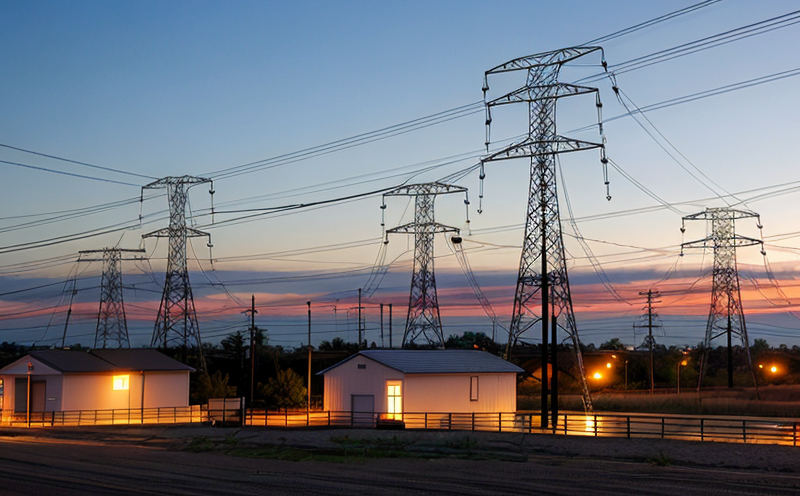ISO 50001 Energy Management System Testing for Grid Reliability
The ISO 50001:2018 standard provides a framework to help organizations improve their energy performance, reduce consumption and costs, and tackle climate change. This certification is particularly valuable in the power & utilities sector where grid reliability plays a critical role. By ensuring compliance with ISO 50001, organizations can enhance their energy management systems (EMS) and contribute significantly to grid stability.
The electrical grid must reliably deliver electricity across vast geographical areas while meeting fluctuating demand. Grid operators face numerous challenges including aging infrastructure, increasing renewable energy integration, and growing customer expectations for uninterrupted power supply. To address these issues effectively, a robust EMS is essential. This system helps utilities optimize their operations by minimizing energy waste and reducing greenhouse gas emissions.
The testing process under ISO 50001 involves several key steps that ensure the reliability of an organization's energy management practices:
- Energy Audits: A thorough assessment of current energy use, identifying areas for improvement and potential savings.
- Data Collection & Analysis: Gathering detailed data on electricity consumption patterns, peak loads, and inefficiencies to inform decision-making processes.
- Implementation Plans: Developing actionable strategies aimed at reducing overall energy consumption without compromising service quality or customer satisfaction.
- Performance Metrics: Establishing clear KPIs (Key Performance Indicators) to measure progress towards set goals, regularly monitoring these metrics through advanced analytics tools.
- Continuous Improvement: Regularly reviewing and updating policies based on new insights gained from ongoing evaluations, ensuring sustained improvements over time.
The testing process also includes internal audits conducted by trained personnel who verify that all aspects of the EMS comply with ISO 50001 requirements. These audits ensure continuous improvement in energy management practices, contributing positively to both operational efficiency and environmental sustainability.
By adhering to this rigorous certification program, power & utilities companies can demonstrate their commitment to responsible resource stewardship, thereby enhancing stakeholder confidence and attracting investment opportunities.
Benefits
Implementing ISO 50001 through comprehensive energy management system testing offers numerous advantages:
- Cost Savings: Reduced utility bills due to optimized resource usage and minimized waste.
- Enhanced Reliability: Improved grid reliability by preventing outages caused by inefficient operations or excessive demand.
- Sustainability: Contribution towards global efforts aimed at reducing carbon footprints, supporting sustainable development goals (SDGs).
- Regulatory Compliance: Meeting regulatory requirements set forth by relevant authorities worldwide.
- Brand Reputation: Establishing a reputation for environmental responsibility and corporate social responsibility (CSR) initiatives.
- Innovation: Encouraging innovation within the organization, fostering creativity in developing new solutions for energy optimization.
- Risk Mitigation: Identifying potential risks associated with non-compliance early on, thereby minimizing financial losses and reputational damage.
- Customer Satisfaction: Ensuring consistent quality of service by maintaining high standards of efficiency and reliability.
These benefits collectively contribute to the overall success of any power & utilities company seeking long-term growth and stability. Compliance with ISO 50001 not only enhances internal operations but also strengthens external relationships, making it an indispensable tool for modern energy management practices.
Environmental and Sustainability Contributions
The implementation of ISO 50001 aligns closely with the principles of environmental sustainability. By focusing on efficient resource utilization and minimizing waste, organizations contribute to a more sustainable future:
- Reduced Carbon Footprint: Lowering emissions through improved energy efficiency leads directly to reduced carbon footprints.
- Water Conservation: Efficient use of water resources is promoted, aligning with broader sustainability goals.
- Biodiversity Preservation: By reducing the overall impact on natural environments, companies help preserve biodiversity.
- Economic Viability: Sustainable practices lead to cost savings and improved economic viability for both businesses and communities.
- Resilience Against Climate Change: Enhanced resilience against climate change impacts through better preparedness and adaptation strategies.
- Community Engagement: Engaging stakeholders in environmental initiatives fosters stronger community ties and support.
- Health & Safety: Ensuring safe working environments contributes to public health and safety, promoting overall well-being.
The interconnected nature of these factors underscores the importance of integrating sustainability into core business activities. Organizations that embrace ISO 50001 demonstrate their dedication to creating a positive impact on society and the environment.
Use Cases and Application Examples
ISO 50001 energy management system testing has wide-ranging applications across various segments of the power & utilities industry:
- Transmission & Distribution Networks: Ensuring efficient operation of transmission lines, substations, and distribution networks.
- Renewable Energy Integration: Supporting the integration of solar, wind, hydroelectric, and other renewable sources into existing grids.
- Demand Response Programs: Facilitating participation in demand response programs to balance supply and demand dynamically.
- Smart Grid Technologies: Optimizing smart grid technologies for enhanced monitoring, control, and management of electricity networks.
- Energy Storage Systems: Maximizing the effectiveness of energy storage systems through efficient charging and discharging cycles.
- Building Management Systems: Integrating building management systems with broader utility operations to optimize energy consumption in commercial and residential buildings.
- Electric Vehicle Infrastructure: Supporting the development of robust EV infrastructure, including charging stations and grid connections.
- Microgrids: Enhancing microgrid performance through optimized energy management practices.
Each of these use cases highlights how ISO 50001 contributes to enhancing grid reliability and efficiency. The standard provides a structured approach for addressing complex challenges faced by the power & utilities sector, ensuring sustainable growth and development.





